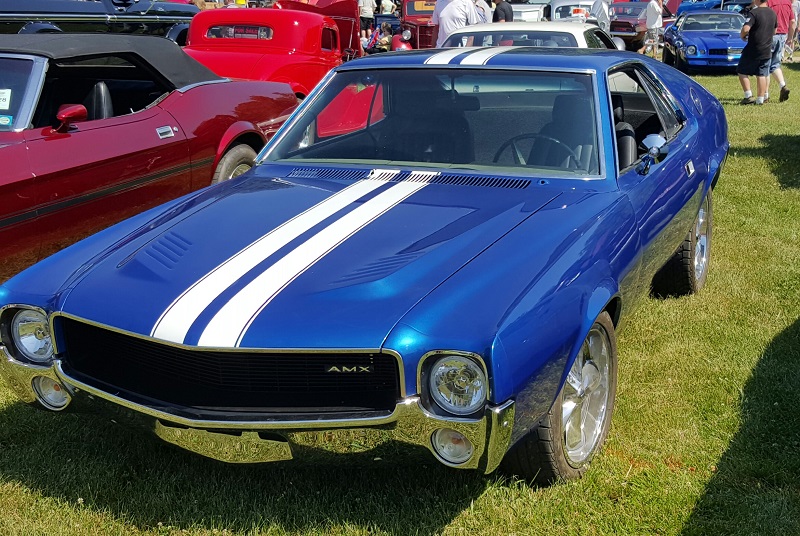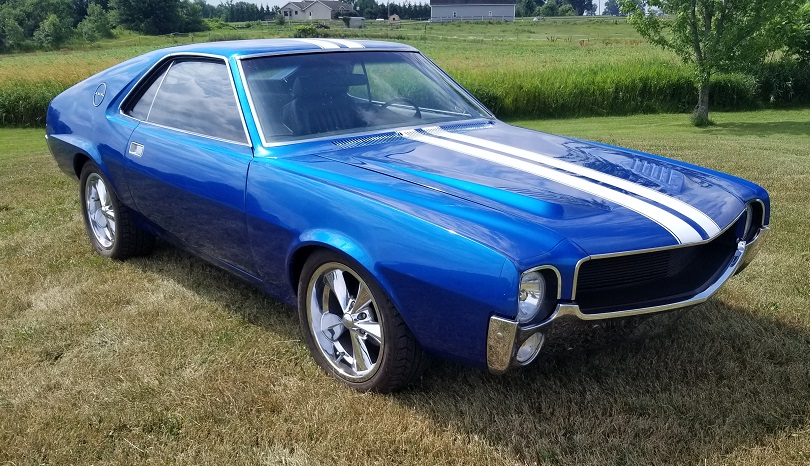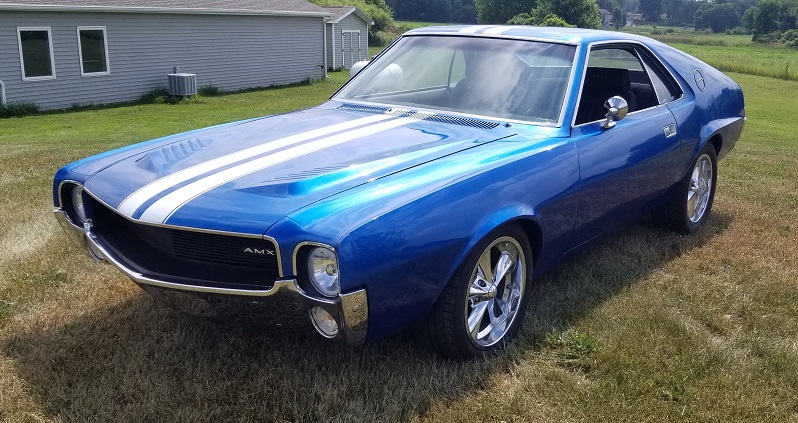For Fan Car Friday this week we bring you “Strobel” and his gorgeous 1968 AMC AMX. Fan Car Friday is a segment where we want to share with the world the automobiles that our fans have. We have absolutely no affiliation/relationship with the cars, the build or the owners. This post was made with written consent from the owner.

“My family has owned this since 1970. I spent 6 years bringing it back to what you see here
When my father obtained the car it had already spent 3 years of it life as a quarter mile car. My father wanted to fix it and put it back as a street legal car. Unfortunately over the years and having 3 boys the car sat in the corner collecting dust. Around 2007 my younger brother wanted to make it back into a drag car but soon after he had a child and no time. I then obtained it and spent 6 years redoing the car. Parts are hard to find especially when I am picky. It had to be original with the exception of a couple of modifications. Ignition needed to be electronic and I updated the 4 speed manual to a tremex tko600 5 speed manual. Now my father sees the car that he envisioned years ago.“

The AMC AMX is a two-seat GT-style sports car that was produced by American Motors Corporation for the 1968 through 1970 model years. The AMX was also classified as a muscle car, but “unique among other American cars at the time due its short wheelbase”. The AMX was also the only American-built steel-bodied two-seater of its time, the first since the 1955–1957 Ford Thunderbird. To a degree, the AMX was a competitor with America’s only other two-seater of the era, the Chevrolet Corvette for substantially less money. With a one-inch (2.5 cm) shorter wheelbase than Chevrolet’s two-seater, the AMX was often seen by the press as a “Corvette competitor”.
Fitted with the optional high-compression medium block 390 cu in (6.4 L) AMC V8 engine, the AMX offered top-notch performance at an affordable price. In spite of this value and enthusiastic initial reception by automotive media and enthusiasts, sales never thrived. However, the automaker’s larger objectives to refocus AMC’s image on performance and to bring younger customers into its dealer showrooms was achieved. After three model years, the two-seat version was discontinued, and the AMX’s now signature badging was transferred to a high-performance version of its four-seat sibling, the Javelin, from the 1971 to 1974 model years.
American Motors capitalized the respected reputation of the original AMXs by reviving the model designation for performance-equipped coupe versions of the compact Hornet in 1977, Concord in 1978, and the subcompact Spirit in 1979 and 1980.

American Motors promoted the mid-model year launch of the AMX to automotive journalists at Daytona to emphasize its sports car performance, as well as with a marketing agreement with Playboy Enterprises. To introduce the AMX to its dealers, AMC held meetings at nine Playboy Clubs.
The AMX was introduced to the public on 24 February 1968, five months after the Javelin and other 1968 AMC cars. It was promoted as “the only American sports car that costs less than $3500”. American Motors advertisements also showed “a helmeted race driver revving up at the starting line in one of AMC’s sporty AMX models, which it describes as ready to do 125 miles an hour.”
The two-seat AMX was “meant for a small, well-defined market niche, and it pulled in young people into AMC dealer showrooms in never before seen numbers”. Numerous road tests described the new AMX as a “handsome two-seater with American-style acceleration and European-style handling”. Journalists gave it a real run workout on all kinds of terrain and wrote “that the AMX is one of the best-looking cars – if not the best-looking car – made in the U.S.A.”.
All AMXs came with four-barrel carbureted small block[36] AMC V8 engines in several versions: 290 cu in (4.8 L) (225 hp (168 kW), N-code), 343 cu in (5.6 L) (290 hp (220 kW), T-code), as well as the 390 cu in (6.4 L) “AMX” featuring 315 hp (235 kW) with 425 pound force-feet (576 N⋅m) of torque (X-code). All derived from the same external sized block. However, the three engines differed vastly internally, with the smallest engine having small intake and exhaust valves, thin block webbing, and a cast nodular iron crankshaft; the 343 used larger valves with a thicker block webbing; and the 390 moved up to a forged steel crankshaft and connecting rods, as well as larger rod bearings, 2.250 in (57.15 mm) compared to 2.090 in (53.09 mm) in the smaller two versions.
A BorgWarner T-10 four-speed manual transmission was standard, as were special traction bars, dual exhaust system, and fatter tires for better traction. A “Shift-Command” three-speed automatic transmission with the capability of manual shifting (BorgWarner model M-11B or M-12) was optional together with a floor console mounted shifter.
A popular “Go-Package” option came with either the four-barrel 343 or 390 engine, and included power assisted front disk brakes, “Twin-Grip” differential, E70x14 red-stripe performance tires on “Magnum 500” styled-steel wheels, heavy-duty suspension with thicker sway-bars, heavy-duty cooling, and other performance enhancements. A wide range of specialized performance parts were also available through AMC dealers for installation on customer’s cars. These were known as “Group 19” parts because of the way AMC organized its parts books.
https://en.wikipedia.org/wiki/AMC_AMX

Want your car to be featured as one of our Fan Car Friday’s post? Know somebody that might? Use the contact link at the bottom and email us a couple of photos as well as your contact information and your vehicle could be featured on an upcoming Friday post. Please make sure to put FAN CAR in the subject heading.
I remember this car when it came out I was shipped overseas in the Navy. To this day when you see an AMX you just say WOW!!!
Super looking car, thanks for sharing.
Is the AMX for sale and if yes how much.
Outstanding automobile! I also have a 68 AMX and just can’t get enough of it. 16,000 miles put on this year. Be proud, yours is a BEAUTIFUL example. Congrats!
What color is the blue? I’m the original owner of a 1972 Javelin AMX in Jetset Blue, the only year the color was offered on the Javelin. The ’68 looks similar to Jetset, but don’t think it is. Is it one on the newer blues out there such as Ford’s 2020 Velocity or Lightning Blue?